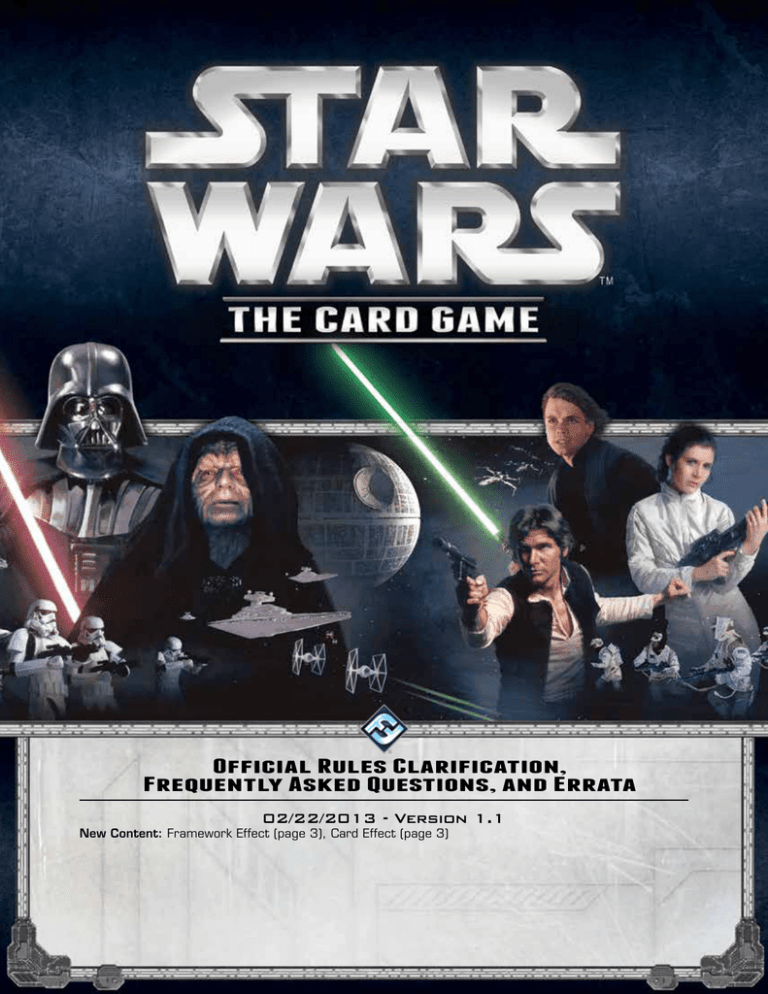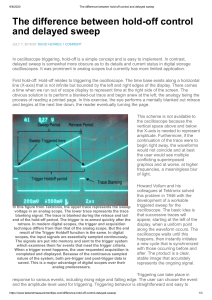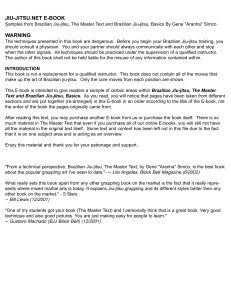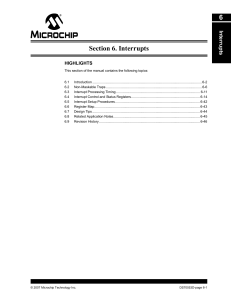Official Rules Clarification, Frequently Asked Questions, and Errata
Anuncio

Official Rules Clarification, Frequently Asked Questions, and Errata 02/22/2013 - Version 1.1 New Content: Framework Effect (page 3), Card Effect (page 3) 1 Card Errata This section contains the official clarifications and errata that have been made on individual cards or sets in Star Wars: The Card Game. The card entries are ordered by the set in which the specified card was printed. The errata on any individual card always applies to all reprinted versions of that card. 2 Core Rulebook Refresh Phase (p. 12) The parenthetical text after step 1, which reads, “...(Any effect with the text “after you refresh” can be used after completing this step)” is misplaced. Most Recent Printing “After you refresh” effects should be initiated after the completion of step 3 of the refresh phase. In the case where an LCG card is reprinted with updated errata text in a later printing, the most recent printing is the legal version of the card. All older LCG printings are assumed to be updated with the errata text. When in doubt over two versions of a card, the most recent printing can be identified by the copyright dates on the cards in question. FFG will see that all LCG reprints with updated errata text are also recorded in the FAQ. Core Set (v1.0) Fleeing the Empire 0056 Should read: “Reaction: After your refresh phase ends, ...” (v1.0) Fleet Command Center 0057 Should read: “Reaction: After your refresh phase ends, ...” Rules Clarifications 1. Draw, Search and Reveal (1.1) Drawing Multiple Cards When a player draws multiple cards (e.g., by drawing 2 cards during his draw phase, or due to a card effect like that of Dark Precognition (Core 0034) ), he is considered to be drawing them one at a time, not all at once. This is important for effects that may initiate by a card being drawn. (1.2) Shuffling After a Search If a player searches any deck for any reason, he must shuffle the deck to the satisfaction of his opponent(s) upon completion of the search. (1.3) Duration of “Reveal” Whenever cards are revealed, they remain revealed until they arrive at their final destination as specified by the effect that caused the card to be revealed. 2. Game Play (2.1) Infinite Loops If it is possible, with certain card combinations, to create an “infinite loop,” then when executing an infinite loop the resolving player must follow these two steps: 1.Clearly display the infinite loop to the opponent (and tournament judge, if the opponent requires it). Thus, the player must display, using all cards involved, one full cycle of the infinite loop. 2.State how many times he or she wishes to execute this loop. For example, the player could say “I will now execute this loop seventeen million times.” Then resolve the loop that many times instantly. If the execution of this loop causes the player to win the game, the game is over and the executing player wins. Infinite loops should never be abused to cause the game to stall. (2.2) Priority of Simultaneous Resolution If a single effect affects multiple players simultaneously, but the players must individually make choices to resolve the effect, the player who played or executed the effect chooses first, with priority then proceeding clockwise around the table. (2.3) Engaging Objectives An objective is considered “engaged” only after steps 1 (Declare objective) and 2 (Declare attackers) on page 18 of the core rules are completed. If these steps are not completed, an engagement has not been declared. (2.4) Facedown Cards in Edge Stacks A player may look at the facedown cards in his own edge stack at any time. 3 (2.5) Facedown Captured Cards The Dark Side player may look at facedown cards captured at his objectives at any time. Barring a card effect that allows him to do so, the Light Side player may not look at facedown captured cards. 3. Card Effects and Abilities (3.1) Cancellation of Effects Effects that are canceled are still considered to have been initiated or played. Only the effects are canceled. Any costs have still been paid, and are not returned or refunded. (3.2) Discard Pile You may not change the order of cards in any discard pile. You may look at any player’s discard pile at any time. (3.3) “Participated” and Removal from an Engagement A unit is only considered to have participated in an engagement if it remains in the engagement through its resolution. If they are removed from an engagement, there is no memory of that unit having participated in that engagement. 4. Definition of Terms (4.1) The word “to” The word “to” as in “Do X to do Y” indicates that X is a cost that must be paid before Y can occur. (4.2) The Letter X Unless specified by a preceding card, card effect, or granted player choice, the letter “X” is always equal to 0. (4.3) Moving Damage Moving damage is not considered dealing damage. However, the unit that receives the moved damage is still considered to have been “damaged.” (For example, a unit with “Protect Character” can be used to absorb damage that is being moved to another Character unit.) (4.4) Framework Effect A Framework Effect is any effect that arises from the resolution of a Framework Event (see pg. 30 of the Core Rulebook), as opposed to an effect that originates from the text of a card. (Note that the resolution of combat icons and counting/comparing Force icons in an edge battle are both Framework Effects.) (4.5) Card Effect A Card Effect is any effect that comes from the resolution of text printed on a card. Advanced Timing Rules While most effects and rules for Star Wars: The Card Game, are simple to resolve and generally without controversy, sometimes card abilities interact in ways that require a more detailed understanding of timing (i.e. when, and the order in which, abilities are resolved]. An interrupt ability must be used when its triggering condition is occurring, before the triggering condition has been fully resolved. Interrupt effects often cancel, redirect, or otherwise change the resolution of the triggering condition. Timing conflicts are generally resolved dependent on the type of card ability in question (see “Card Abilities” on pages 24-25 of the core rulebook). This section provides detailed rules to help players resolve advanced timing issues. The active player always has the first opportunity to use an ability that interrupts a given triggering condition, followed by his opponent, after which the active player may use another interrupt, and so forth. Interrupt opportunities for that triggering condition pass back and forth between players in this manner until both players have passed consecutively. F ramework E vents and A ction W indows There are two basic elements of activity upon which the play of the game advances: the Framework Event and the Action Window. are activities that are dictated by the game rules rather than by player choice; they are the fundamental occurences and rituals that propel the game forward. Framework event windows cannot be broken by player actions. The grey framework event windows in the Timing Structure diagram on pages 30-31 of the core rulebook identify each of the game’s framework events. framework events Action effects (those denoted by a bold “Action” trigger on a card) may only be initiated by players during a turn’s action windows. The blue action windows in the Timing Structure diagram on pages 30-31 of the core rulebook identify the opportunities in which players may initiate actions throughout a turn. A ction A bilities When an action window opens, the active player has the first opportunity to take an action, followed by his opponent. Then, the active player may take another action,and so forth. In this way, the option to take an action passes back and forth between the players until both players consecutively pass. An action ability is always fully resolved before the next begins, or before the game proceeds. I nterrupt A bility T iming Interrupt abilities can be used during framework event windows and also during action windows, provided that the triggering condition indicated by the interrupt ability’s text is true. For example: The card abillity of the Leia Organa unit card reads “Interrupt: When this unit leaves play, remove all focus tokens from all cards you control.” The words “When this unit leaves play” describe the triggering condition that must be occuring for this ability to be used. 4 Once the opportunity to interrupt a triggering condition has been passed, that condition itself resolves (if it has not been canceled), and further interrupts to that specific triggering condition may not be used. R eaction A bility T iming Reaction abilities can be used during framework event windows and also during action windows, provided that the triggering condition indicated by the reaction abilitiy’s text is true. For example: The card ability of the Nightsister unit card reads “Reaction: After you commit this unit to the Force, deal 1 damage to a target objective”. The words “After you commit this unit to the Force” describe the triggering condition that must be true for this reaction to be used. A reaction ability is always used immediately after its triggering condition has occurred and has been resolved. The active player always has the first opportunity to use an ability in reaction to a given triggering condition, followed by his opponent after which the active player may use another reaction, and so forth. Reaction opportunities for that triggering condition pass back and forth between players in this manner until both players have passed consecutively. Once the opportunity to react to a triggering condition has been passed, further reactions to that specific triggering condition may not be used. I nterrupt and R eaction P riority In the case where both interrupt and reaction abilities could be taken from the same triggering condition–– interrupt effects have a priority, and must be initiated and resolved first. (Interrupts will always be used and resolve before the triggering condition itself, the triggering condition will resolve second, and reactions to that condition will be used and reasolve third.) If the triggering condition still is true after resolving all interrupt effects (i.e., the triggering condition has not been cancelled), reaction abilities may then be taken. E ffect R esolution When a player wishes to play a card, take an action, or initiate an interrupt or reaction effect, he first declares his intent. The following steps are then observed, in order: 1) Check play restrictions: can the card be played, or the effect initiated, at this time? 2) Determine the cost (or costs, if multiple costs are required) to play the card or initiate the effect. 3) Apply any modifiers to the cost. 4) Pay the cost(s). 5) Choose target(s), if applicable. 6) The card is played, or the effect resolves. If any of the above steps would make the triggering condition of an Interrupt effect true, that effect may be initiated when that triggering condition becomes true. If any of the above steps would make the triggering condition of a Reaction effect true, that effect may be initiated just after the triggering condition becomes true. N ested E ffect S equences Effects generally resolve in a “first in, first out” manner. For instance, if a player has two reaction effects he wishes to play in reaction to a single triggering condition, the first reaction is played and resolved in its entirety, and then the second reaction is played and resolved. It is possible, however, for an interrupt or reaction effect to cause a new triggering condition that could itself trigger a subsequent series of interrupt and reaction effects. Such effects will nest on top of one another, creating a sequence of effects, and these sequences need to be resolved in a “last in, first out” manner. For example: During an engagement, Tom’s unit, Yoda, is dealt damage by an enemy strike. This is the triggering event that allows the card Lightsaber Deflection to be played, which allows Tom to redirect 1 point of that damage to an enemy unit. Tom’s opponent, Kris, does not want this to occur. When Tom attempts to play Lightsaber Deflection, Kris interrupts its execution by playing It’s Worse! This card attempts to cancel the effects of Tom’s Lightsaber Deflection. Tom, however, is able to play Counter-stroke, which interrupts Kris’s attempt to play an event card, and therefore cancels the effects of It’s Worse. At this point, neither player has any more 5 Interrupt or Reaction effects that can be played, so Counter-stroke resolves (being the final nested effect played in the sequence), canceling the effects of It’s Worse. Since these effects were canceled, It’s Worse does not resolve (it is simply discarded), and the Lightsaber Deflection now resolves,redirecting one point of the damage away from Yoda. If either player now has another Interrupt to the original triggering condition (damage being dealt to Yoda), it can be played or initiated at this time. When such a sequence of effects occurs, players should keep playing and triggering effects until the chain of sequences runs dry (i.e. there are no interrupts or reactions to the resolution of all effects from the last effect played in the sequence). The most recently played nested effect sequence is always completely resolved before any former sequence of effects is resolved. Frequently Asked Questions If I have a TIE Attack Squadron (Core 147) in a battle and I place a Twist of Fate (Core 0157 or 0171) but no other Fate cards in my edge stack, does the TIE Attack Squadron gain the bonus æ icon and targeted strike keyword? If the only character I control in an engagement is killed during the edge battle (such as from an opponent’s Heat of Battle (Core 0065 or 0169) ), what happens to the edge battle? Yes. The TIE Attack Squadron’s passive ability checks whether or not you have placed any Fate cards into any of your edge stacks during an edge battle this engagement. Even if those Fate cards are canceled (by an opponent’s Twist of Fate), or if the resolution of the Edge Battle is canceled (by your own Twist of Fate), a Fate card has still been placed, and you would still gain the bonus æ icon and targeted strike keyword. It still resolves as normal. A player can win the edge battle and have no characters left over, which would keep his opponent’s characters from gaining their edgeenabled icons for that combat. If I damage an opponent’s unit with Boba Fett (Core 0019) and deal enough damage to destroy the unit, do I capture or destroy the unit? The unit is destroyed. Boba Fett’s ability is a reaction that captures a unit. The damage from the combat icons is applied to the unit and that unit is immediately discarded if it has damage equal to or greater than its damage capacity. You may not capture units from an out of play state (such as the discard pile) unless specifically noted otherwise by a card effect. When you are constructing your deck, if you include an objective that contains a certain card (Sith Library (Core 0072) for example), do you have to use the version of the card from that objective set or could you instead use the same card with a different objective set number at the bottom? No, you must use the version with the objective set number that matches the objective you placed in your objective deck. 6 Can I use the ability on the Tribal Support (Core 0151) objective to discard a card from my hand even if there are no Ewok units in my discard pile? Yes, you can. The Tribal Support objective does not target anything. You can initate an effect that does not target even if you cannot complete that action successfully. If I strike with an attacking character with both the Shii-Cho Training (Core 0122) enhancement and the targeted strike keyword, what happens? You can choose which of the two effects you would like to use, they do not work together. Shii-Cho Training gives you the option to divide the striking unit’s damage among participating units, targeted strike gives you the option to deal the striking unit’s damage to a nonparticipating unit. You may use one effect or the other, but they do not work together. (You may also use neither effect, if you wish to deal damage as per the standard game rules, to a single participating enemy unit.) attackers have been declared. It is at this point that the interrupt on The Secret of Yavin 4 can be triggered. Your opponent’s units will already have been chosen for the attack and already committed. The original objective is still considered to have been “engaged” this phase (and may not be engaged again); The Secret of Yavin 4 is still eligible to be engaged if your opponent has not yet declared an engagement against it. If my opponent sacrifices his X-Wing Escort (Core 0164) using Heroic Sacrifice (Core 0047), which effect occurs first, the X-Wing’s Interrupt or the targeting of Heroic Sacrifice? From the “Effect Resolution” section of the Advanced Timing rules above, you would pay the costs of Heroic Sacrifice, sacrificing a Vehicle, before you would chose the targets for the event. The X-Wing Escort’s Interrupt effect resolves at the time that the cost is paid, so it occurs before the target of Heroic Sacrifice is chosen. If your opponent sacrifices his only Vehicle of cost 4 or less to the X-Wing Escort’s ability, the remaining effect of Heroic Sacrifice no longer has a legal target and therefore does nothing. How does the reaction on Red Two (Core 0114) work? Does it allow me to attack another objective or will Red Two be forced to strike again? It will depend on when the objective is destroyed. If the objective under attack is destroyed during the strike step of an engagement, Red Two will be forced to strike again, as it will be a ready unit during the striking step. However, if the objective is destroyed via the unopposed damage at the end of engagement resolution or at any time not during the striking step of engagement resolution, Red Two will be ready and available to enter another engagement if desired. When can I use the interrupt on The Secret of Yavin 4 (Core 0144) objective? Is my opponent allowed to attack the original objective again after the engagement at The Secret of Yavin 4 has resolved? From Section “(2.3) Engaging Objectives” of the Rules Clarifications section, the objective is only “engaged” after the original objective and all © 2013 Lucasfilm Ltd. & TM. All rights reserved. © 2013 Fantasy Flight Publishing, Inc. Fantasy Flight Games, the FFG Logo, Living Card Game, and LCG are TM or ® of Fantasy Flight Publishing, Inc. All rights reserved. 7 If I destroy my opponent’s A Journey to Dagobah (Core 0003) objective and he uses its interrupt to search for a new cbjective and put it into play while I still have units left to strike that have blast damage, what happens? The new objective is not considered engaged when it enters play and does not receive damage from the resolution of the current engagement. All participating units are still required to strike, even though the engaged objective has left play. Can I use a shield to prevent damage that I am reassigning to one of my own units via the protect keyword? So long as the damage came from a source controlled by your opponent, the shield token will cancel one of the damage that is being transferred via the protect keyword. The source of the damage is still an opponent’s effect, so the shield can prevent that damage. If my unit with the protect keyword has a shield, how much damage am I allowed to transfer to it? Up to the protecting unit’s remaining damage capacity, as per the normal rules for the protect keyword. The presence of the shield does not change the amount of damage you can transfer via the protect keyword. When Trench Run (Core 0150) is in play, which effects can and cannot interact with the Death Star dial as an objective? Because the Death Star dial is explicitly not an objective, card effects that interact with objectives do not interact with the Death Star dial. When engaged as an objective, the Death Star dial may be damaged by framework effects only (see “(4.4) Framework Effect” on page 3). This is limited to º (blast) damage and unopposed damage.



